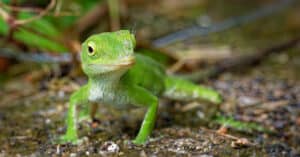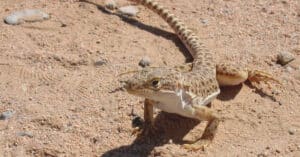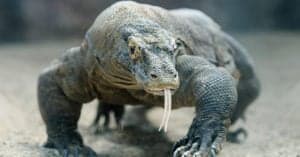Discover 10 Incredible Lizards in Florida
Thanks to its uniquely warm, humid, borderline tropical climate, Florida is home to a wide range of animals that would normally not thrive in the United States’ more temperate regions. Florida’s reptiles are especially diverse and impressive, with the state being home to more than 100 colorful, distinct, and incredible lizards, tortoises, snakes, and more! In fact, lizards in Florida make up more than half of the state’s resident reptiles.
Let’s take a look at 10 of Florida’s most amazing lizards you’re likely to come across at some point in the famed Sunshine State. Some are native, some are not–but all of them have made themselves right at home and are here to soak up the sun.
1. Florida Scrub Lizard (Sceloporus woodii)

Phillip W. Kirkland/Shutterstock.com
The first lizard on our list is one that, as its name suggests, is primarily found within Florida’s dry, sandy, forested scrub regions. While it is native to the state and fairly widespread, the Florida scrub lizard is also currently threatened by habitat loss.
Its scientific name is after Nelson R. Wood, a taxidermist who collected the first Sceloporus woodii specimen to be studied extensively in 1918.
This little brown reptile maxes out at around 4 to 5 inches from snout to tail tip. Its body is light brown to light grey in color with a darker brown stripe running vertically down each side of its back. It is also a slightly sexually dimorphic species. Only the males have bright blue patches on their bellies and throats. Male scrub lizards are also slightly larger than females.
2. Green Anole (Anolis carolinensis)
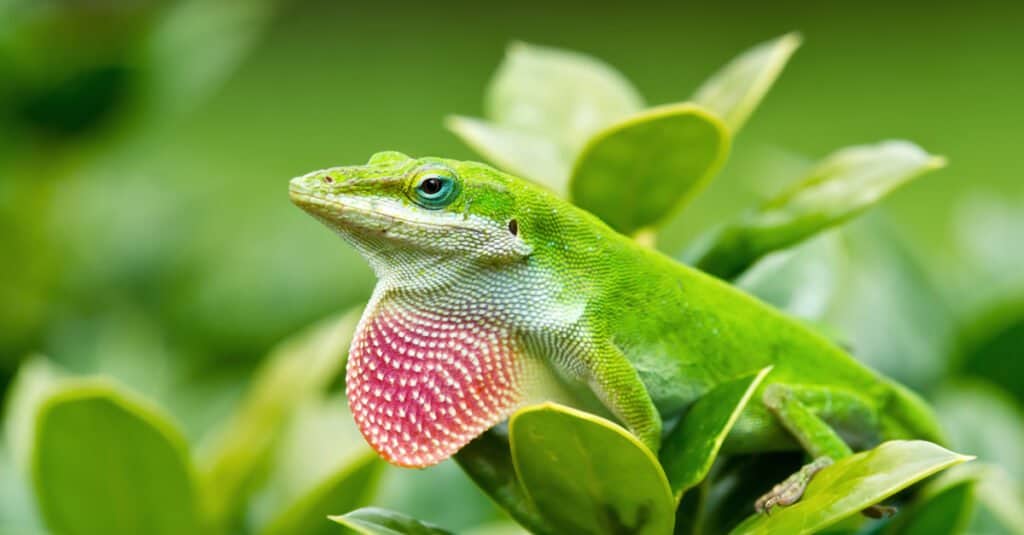
Leena Robinson/Shutterstock.com
While the green anole is native to much of the Southeast United States, it is perhaps most abundant throughout Florida! These vibrant little lizards are bright green from head to tail with a light green to white underside. They range in size from around 4 to 7 inches long, with male anoles being slightly heavier and longer than females on average.
Additionally, males of the species have bright pink to red dewlaps, or flaps of skin under the chin used primarily for territorial and courtship displays. To make themselves look larger and more intimidating, male green anoles will extend their brightly-colored dewlaps outward from their bodies.
Interestingly, this species has become quite popular in the exotic pet trade. Its success in captivity can be attributed to its small size, hardy nature, manageable care requirements, and fairly mild-mannered and non-aggressive (if somewhat skittish) temperament.
3. Reef gecko (Sphaerodactylus notatus)
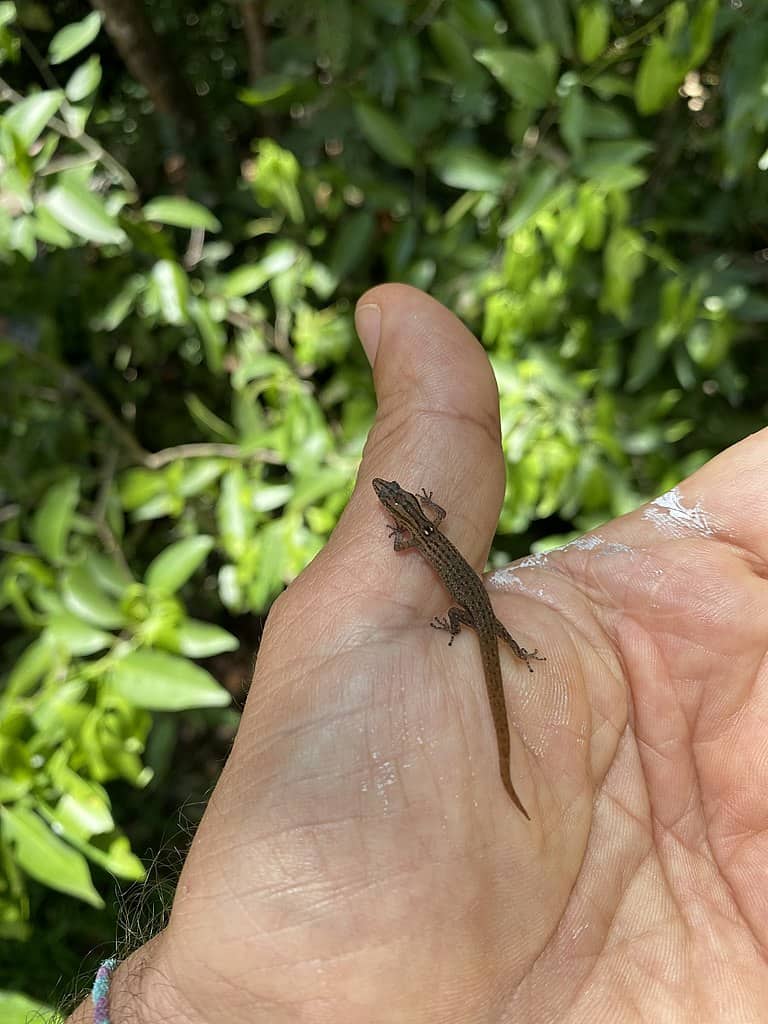
John William Bailly / Creative Commons – License
Another one of Florida’s most widespread and recognizable lizards is the reef gecko. It is also sometimes known as the Florida reef gecko or the brown-speckled sphaero. In addition to being Florida’s only native gecko, the reef gecko is endemic to much of the Caribbean islands.
Like most gecko species, the reef gecko prefers damp, humid, densely forested habitats, particularly those in coastal areas. Its small size (roughly 2 inches long) and dark brown body color with light brown, irregular spots provide it with excellent camouflage amongst the surrounding tree bark and leaf litter. What’s more, the reef gecko is extremely agile, making it a challenging meal for most of its natural predators.
Sadly, the reef gecko is likely one of the United States’ only native gecko species. Historically, there has been much debate amongst herpetologists as to whether or not the species should be considered truly native to the area. For many years, little was known about how and when the reef geckos first arrived in Florida.
Today, reptile experts largely believe the geckos arrived in South Florida via oceanic dispersal, or “rafting.”
4. Eastern Fence Lizard (Sceloporus undulata)
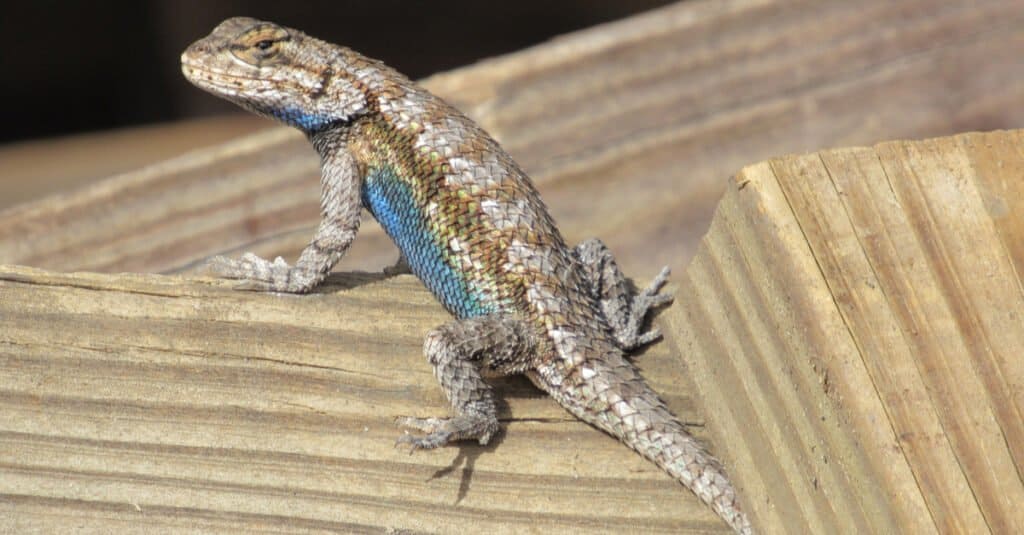
Isabel Eve/Shutterstock.com
These hardy little lizards are widespread throughout much of the Eastern United States. In fact, you can find them from Pennsylvania all the way down to Florida! Because they prefer fairly temperate climates, though, they’re far more abundant in Northern Florida than the more tropical southern half of the state.
The typical eastern fence lizard is a mottled gray and brown in color with darker brown markings running vertically down its sides. A fully-grown individual can range from roughly 4 to 7 inches long from snout to tail tip. Its keeled scales splay outward from its body, particularly around its legs and tail.
This species is also sexually dimorphic, with males having bright blue markings on their bellies. Their colors can also shift slightly depending on certain factors like their body temperature or health conditions. Notably, the males’ blue markings become more vibrant during courtship displays with female eastern fence lizards.
5. Six-lined Racerunner (Aspidoscelis sexlineatus)

Mike Wilhelm/Shutterstock.com
True to its name, the six-lined racerunner has six equally-spaced yellow stripes running vertically down the length of its body from the base of the neck to the tip of the tail. Its base body color is typically dark green or dark brown. Much of its 6-to-9-inch body length is composed of its long, slender tail.
The six-lined racerunner is also an incredibly fast-moving lizard! It is capable of running up to a whopping 18 miles per hour when threatened. Its agile, speedy nature is a helpful defense mechanism from its many natural predators in the wide range of habitats it occupies throughout Florida. It’s hardy enough to tolerate living in the driest of rocky outcroppings as well as dense forests and even very hot and humid coastal regions, too.
In addition to being native to the Sunshine State, this lizard is also common throughout the Southeast United States as well as northern Mexico.
6. Florida Sand Skink (Plestiodon reynoldsi)

Public Domain – License
True to its name on all accounts, the Florida sand skink is native to Florida, lives in the sand, and is most certainly a member of the Scincidae family! At first glance, though, you’d be forgiven for thinking it was a snake–or even an overgrown earthworm of some kind.
These truly bizarre lizards’ legs are so tiny they’re almost invisible to the naked eye. Fortunately, they don’t need limbs, as they mostly wiggle around underground in the sand using their shovel-like heads and long, muscular bodies. Their typical body color is a light brown, sandy hue with tiny, mottled darker brown spots throughout.
Modest in size, Florida sand skinks measure at only around 4 to 5 inches when fully grown. Despite this, they are exceptionally hardy. The species is perfectly suited to living underground in Central Florida’s driest, sandiest scrublands.
7. Green Iguana (Iguana iguana)
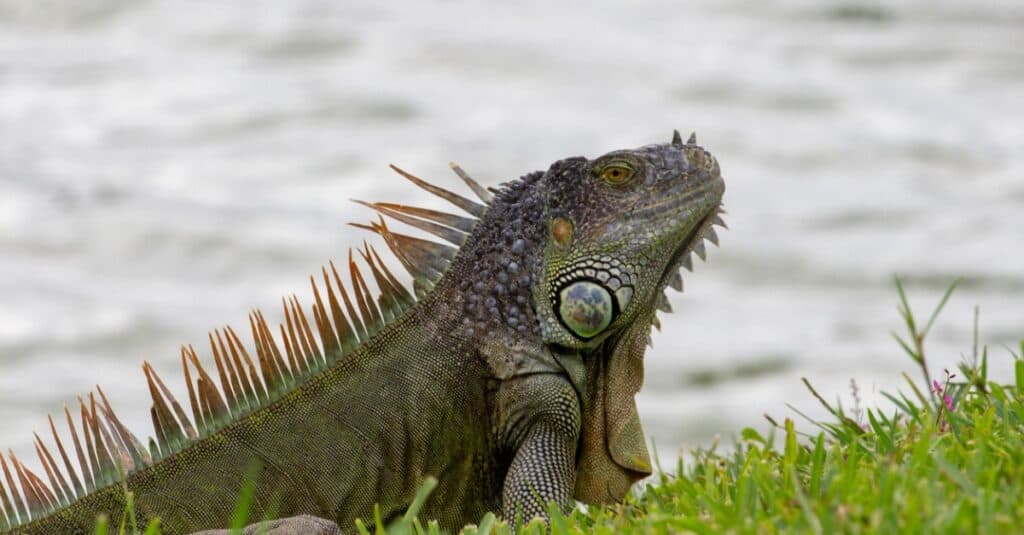
iStock.com/Stacie Acevedo
Although it is one of Florida’s most abundant lizards by far, the green iguana is sadly not native to the US’ third-most populous state. However, this invasive and destructive species seems to be here to stay–at least until the state’s wildlife authorities’ conservation efforts manage to catch up to them. The first green iguanas were likely brought to Florida via ships transporting goods from the Caribbean as well as Central and South America.
Since they arrived in the 1960s, the green iguanas’ numbers absolutely exploded in Florida (and, later, Texas and Hawaii). At around 4 to 6 feet in length and weighing 10 to 20 pounds on average, these strong, agile, and intelligent herbivores are capable of easily decimating crop supplies and devouring various other native animals’ food sources.
What’s more, they are quite hardy, prolific breeders, and Florida’s climate has proven to be just right for them to reproduce en masse. They commonly hijack and destroy other animals’ burrows and nests and are occasionally even territorial and aggressive towards humans, as they have become less fearful of human interaction over time.
One rather sad and morbid factor that has helped to lower their numbers, though, is the winter “iguana showers” observed yearly by Florida residents. Essentially, green iguanas brumate in the tops of tall palm trees when temperatures drop for the winter, which leads to them falling out of the trees–often to their death–in massive numbers.
8. Broadhead skink (Plestiodon laticeps)
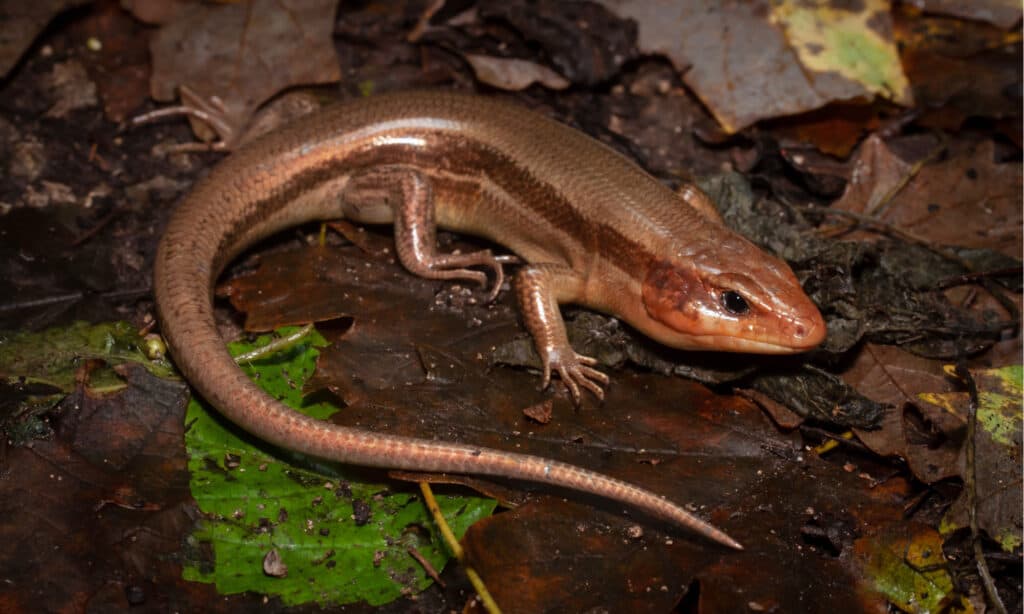
Mike Wilhelm/Shutterstock.com
The broadhead skink is a substantial reptile with a bulky body and a wide, triangular head. It’s native to much of Northern Florida as well as the Southeast United States in general. In fact, its impressive geographic range stretches eastward from Texas to North Carolina and south from Pennsylvania down to Florida.
From snout to tail tip, the average fully-grown broadhead skink is around 6 to 13 inches long. Its body color is mainly brown with a white or light tan underside. The species is slightly sexually dimorphic. During the skinks’ mating season, the males’ heads will become bright orange in color. Females also have five thin, white stripes running down their backs, while males are solid in color.
These semi-arboreal lizards are surprisingly capable climbers despite their heavy, wide bodies and small limbs. They fare best in warm yet temperate climates. Because of this, they primarily live in Central and Northern Florida rather than the more tropical southern half of the state.
9. Cuban Brown Anole (Anolis sagrei)

Natalia Kuzmina/Shutterstock.com
Native to–you guessed it–Cuba, the highly invasive Cuban brown anole has managed to spread far beyond its original home. Small yet exceptionally hardy in nature, these unassuming brown lizards have migrated all the way to parts of Mexico, the Southeast United States, and even parts of Asia! They’ve accomplished this feat primarily by laying their tiny eggs in the soil-filled pots of plants that were exported from Cuba and the Bahamas to various locations.
The Cuban brown anole is small and slender, usually measuring around 5 to 8 inches from snout to tail tip. Aside from its mottled dark brown color, it is similar in appearance to the aforementioned green anole. Additionally, the males’ dewlaps are more of an orange or yellow color than the green anoles’ pinkish-red dewlaps. Finally, brown anoles’ tails have a slightly raised ridge that stretches up the body to the base of the neck.
Compared to their green cousins, brown anoles also differ slightly when it comes to their preferred habitats. While green anoles are very arboreal in nature, brown anoles prefer living lower to the ground. The lizards’ dark, irregularly patterned coloration helps them blend in well with the surrounding tree bark and leaf litter.
10. Nile Monitor (Varanus niloticus)

Dave Montreuil/Shutterstock.com
Didn’t expect to see a monitor lizard–much less a Nile monitor–on this list, did you? Thankfully, this gigantic, fearsome lizard isn’t actually native to Florida. However, in recent years, it has unfortunately arisen as an invasive species in the Sunshine State’s more swampy, humid regions.
Just like its name implies, the Nile monitor is native to Sub-Saharan Africa’s harshest, most remote forests and savannahs. Here, it is commonly spotted lurking along the Nile River, where it hunts, bathes, and hydrates itself daily.
At an enormous 4 to 7 feet in length, the typical Nile monitor is long, heavily muscled, and surprisingly swift. Its body is dark brown in color with a lighter, yellowish underside. On its back are many small, irregular yellow spots, while its tail is marked by yellow bands.
Since the 1990s, experienced reptile hobbyists have kept Nile monitors as pets. It is believed that, over time, the lizards were unintentionally introduced to the wild via the pet trade. They have been spotted throughout South Florida since the early 2000s.
In particular, Nile monitors have established small yet increasingly destructive populations in the Everglades and its surrounding swamps.
More from A-Z Animals
Thanks to its uniquely warm, humid, borderline tropical climate, Florida is home to a wide range of animals that would normally not thrive in the United States’ more temperate regions. Florida’s reptiles are especially diverse and impressive, with the state being home to more than 100 colorful, distinct, and incredible lizards, tortoises, snakes, and more! In fact, lizards in Florida make up more than half of the state’s resident reptiles.
Let’s take a look at 10 of Florida’s most amazing lizards you’re likely to come across at some point in the famed Sunshine State. Some are native, some are not–but all of them have made themselves right at home and are here to soak up the sun.
1. Florida Scrub Lizard (Sceloporus woodii)

Phillip W. Kirkland/Shutterstock.com
The first lizard on our list is one that, as its name suggests, is primarily found within Florida’s dry, sandy, forested scrub regions. While it is native to the state and fairly widespread, the Florida scrub lizard is also currently threatened by habitat loss.
Its scientific name is after Nelson R. Wood, a taxidermist who collected the first Sceloporus woodii specimen to be studied extensively in 1918.
This little brown reptile maxes out at around 4 to 5 inches from snout to tail tip. Its body is light brown to light grey in color with a darker brown stripe running vertically down each side of its back. It is also a slightly sexually dimorphic species. Only the males have bright blue patches on their bellies and throats. Male scrub lizards are also slightly larger than females.
2. Green Anole (Anolis carolinensis)

Leena Robinson/Shutterstock.com
While the green anole is native to much of the Southeast United States, it is perhaps most abundant throughout Florida! These vibrant little lizards are bright green from head to tail with a light green to white underside. They range in size from around 4 to 7 inches long, with male anoles being slightly heavier and longer than females on average.
Additionally, males of the species have bright pink to red dewlaps, or flaps of skin under the chin used primarily for territorial and courtship displays. To make themselves look larger and more intimidating, male green anoles will extend their brightly-colored dewlaps outward from their bodies.
Interestingly, this species has become quite popular in the exotic pet trade. Its success in captivity can be attributed to its small size, hardy nature, manageable care requirements, and fairly mild-mannered and non-aggressive (if somewhat skittish) temperament.
3. Reef gecko (Sphaerodactylus notatus)

John William Bailly / Creative Commons – License
Another one of Florida’s most widespread and recognizable lizards is the reef gecko. It is also sometimes known as the Florida reef gecko or the brown-speckled sphaero. In addition to being Florida’s only native gecko, the reef gecko is endemic to much of the Caribbean islands.
Like most gecko species, the reef gecko prefers damp, humid, densely forested habitats, particularly those in coastal areas. Its small size (roughly 2 inches long) and dark brown body color with light brown, irregular spots provide it with excellent camouflage amongst the surrounding tree bark and leaf litter. What’s more, the reef gecko is extremely agile, making it a challenging meal for most of its natural predators.
Sadly, the reef gecko is likely one of the United States’ only native gecko species. Historically, there has been much debate amongst herpetologists as to whether or not the species should be considered truly native to the area. For many years, little was known about how and when the reef geckos first arrived in Florida.
Today, reptile experts largely believe the geckos arrived in South Florida via oceanic dispersal, or “rafting.”
4. Eastern Fence Lizard (Sceloporus undulata)

Isabel Eve/Shutterstock.com
These hardy little lizards are widespread throughout much of the Eastern United States. In fact, you can find them from Pennsylvania all the way down to Florida! Because they prefer fairly temperate climates, though, they’re far more abundant in Northern Florida than the more tropical southern half of the state.
The typical eastern fence lizard is a mottled gray and brown in color with darker brown markings running vertically down its sides. A fully-grown individual can range from roughly 4 to 7 inches long from snout to tail tip. Its keeled scales splay outward from its body, particularly around its legs and tail.
This species is also sexually dimorphic, with males having bright blue markings on their bellies. Their colors can also shift slightly depending on certain factors like their body temperature or health conditions. Notably, the males’ blue markings become more vibrant during courtship displays with female eastern fence lizards.
5. Six-lined Racerunner (Aspidoscelis sexlineatus)

Mike Wilhelm/Shutterstock.com
True to its name, the six-lined racerunner has six equally-spaced yellow stripes running vertically down the length of its body from the base of the neck to the tip of the tail. Its base body color is typically dark green or dark brown. Much of its 6-to-9-inch body length is composed of its long, slender tail.
The six-lined racerunner is also an incredibly fast-moving lizard! It is capable of running up to a whopping 18 miles per hour when threatened. Its agile, speedy nature is a helpful defense mechanism from its many natural predators in the wide range of habitats it occupies throughout Florida. It’s hardy enough to tolerate living in the driest of rocky outcroppings as well as dense forests and even very hot and humid coastal regions, too.
In addition to being native to the Sunshine State, this lizard is also common throughout the Southeast United States as well as northern Mexico.
6. Florida Sand Skink (Plestiodon reynoldsi)

Public Domain – License
True to its name on all accounts, the Florida sand skink is native to Florida, lives in the sand, and is most certainly a member of the Scincidae family! At first glance, though, you’d be forgiven for thinking it was a snake–or even an overgrown earthworm of some kind.
These truly bizarre lizards’ legs are so tiny they’re almost invisible to the naked eye. Fortunately, they don’t need limbs, as they mostly wiggle around underground in the sand using their shovel-like heads and long, muscular bodies. Their typical body color is a light brown, sandy hue with tiny, mottled darker brown spots throughout.
Modest in size, Florida sand skinks measure at only around 4 to 5 inches when fully grown. Despite this, they are exceptionally hardy. The species is perfectly suited to living underground in Central Florida’s driest, sandiest scrublands.
7. Green Iguana (Iguana iguana)

iStock.com/Stacie Acevedo
Although it is one of Florida’s most abundant lizards by far, the green iguana is sadly not native to the US’ third-most populous state. However, this invasive and destructive species seems to be here to stay–at least until the state’s wildlife authorities’ conservation efforts manage to catch up to them. The first green iguanas were likely brought to Florida via ships transporting goods from the Caribbean as well as Central and South America.
Since they arrived in the 1960s, the green iguanas’ numbers absolutely exploded in Florida (and, later, Texas and Hawaii). At around 4 to 6 feet in length and weighing 10 to 20 pounds on average, these strong, agile, and intelligent herbivores are capable of easily decimating crop supplies and devouring various other native animals’ food sources.
What’s more, they are quite hardy, prolific breeders, and Florida’s climate has proven to be just right for them to reproduce en masse. They commonly hijack and destroy other animals’ burrows and nests and are occasionally even territorial and aggressive towards humans, as they have become less fearful of human interaction over time.
One rather sad and morbid factor that has helped to lower their numbers, though, is the winter “iguana showers” observed yearly by Florida residents. Essentially, green iguanas brumate in the tops of tall palm trees when temperatures drop for the winter, which leads to them falling out of the trees–often to their death–in massive numbers.
8. Broadhead skink (Plestiodon laticeps)

Mike Wilhelm/Shutterstock.com
The broadhead skink is a substantial reptile with a bulky body and a wide, triangular head. It’s native to much of Northern Florida as well as the Southeast United States in general. In fact, its impressive geographic range stretches eastward from Texas to North Carolina and south from Pennsylvania down to Florida.
From snout to tail tip, the average fully-grown broadhead skink is around 6 to 13 inches long. Its body color is mainly brown with a white or light tan underside. The species is slightly sexually dimorphic. During the skinks’ mating season, the males’ heads will become bright orange in color. Females also have five thin, white stripes running down their backs, while males are solid in color.
These semi-arboreal lizards are surprisingly capable climbers despite their heavy, wide bodies and small limbs. They fare best in warm yet temperate climates. Because of this, they primarily live in Central and Northern Florida rather than the more tropical southern half of the state.
9. Cuban Brown Anole (Anolis sagrei)

Natalia Kuzmina/Shutterstock.com
Native to–you guessed it–Cuba, the highly invasive Cuban brown anole has managed to spread far beyond its original home. Small yet exceptionally hardy in nature, these unassuming brown lizards have migrated all the way to parts of Mexico, the Southeast United States, and even parts of Asia! They’ve accomplished this feat primarily by laying their tiny eggs in the soil-filled pots of plants that were exported from Cuba and the Bahamas to various locations.
The Cuban brown anole is small and slender, usually measuring around 5 to 8 inches from snout to tail tip. Aside from its mottled dark brown color, it is similar in appearance to the aforementioned green anole. Additionally, the males’ dewlaps are more of an orange or yellow color than the green anoles’ pinkish-red dewlaps. Finally, brown anoles’ tails have a slightly raised ridge that stretches up the body to the base of the neck.
Compared to their green cousins, brown anoles also differ slightly when it comes to their preferred habitats. While green anoles are very arboreal in nature, brown anoles prefer living lower to the ground. The lizards’ dark, irregularly patterned coloration helps them blend in well with the surrounding tree bark and leaf litter.
10. Nile Monitor (Varanus niloticus)

Dave Montreuil/Shutterstock.com
Didn’t expect to see a monitor lizard–much less a Nile monitor–on this list, did you? Thankfully, this gigantic, fearsome lizard isn’t actually native to Florida. However, in recent years, it has unfortunately arisen as an invasive species in the Sunshine State’s more swampy, humid regions.
Just like its name implies, the Nile monitor is native to Sub-Saharan Africa’s harshest, most remote forests and savannahs. Here, it is commonly spotted lurking along the Nile River, where it hunts, bathes, and hydrates itself daily.
At an enormous 4 to 7 feet in length, the typical Nile monitor is long, heavily muscled, and surprisingly swift. Its body is dark brown in color with a lighter, yellowish underside. On its back are many small, irregular yellow spots, while its tail is marked by yellow bands.
Since the 1990s, experienced reptile hobbyists have kept Nile monitors as pets. It is believed that, over time, the lizards were unintentionally introduced to the wild via the pet trade. They have been spotted throughout South Florida since the early 2000s.
In particular, Nile monitors have established small yet increasingly destructive populations in the Everglades and its surrounding swamps.


